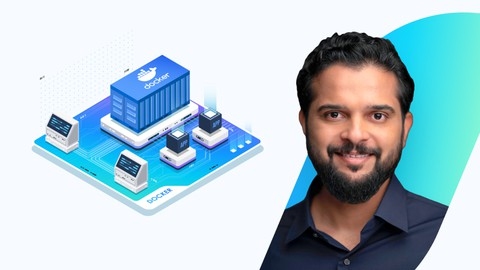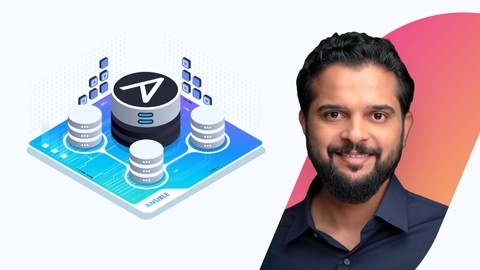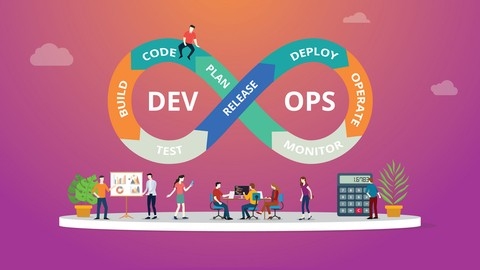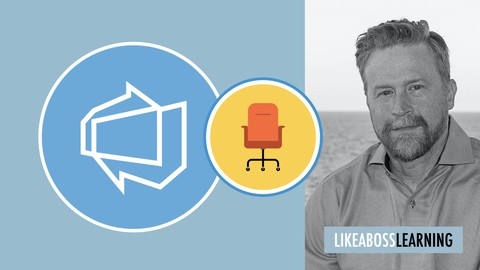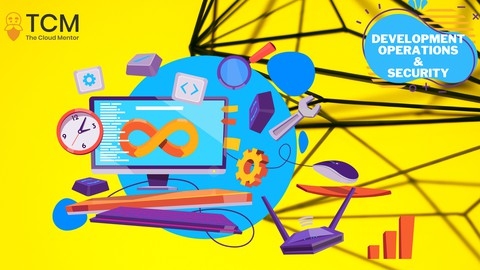DevOps is a set of practices that combines software development (Dev) and IT operations (Ops) to shorten the systems development life cycle and provide continuous delivery with high software quality.
DevOps aims to automate and integrate the processes between software development and IT teams, allowing for faster and more reliable software releases.
By mastering DevOps, you can gain valuable skills that are highly sought-after in today’s technology industry, allowing you to build a fulfilling career in a field that’s constantly evolving.
Finding the right DevOps course on Udemy can be a challenging task.
With so many options available, it can be difficult to determine which course is best suited for your needs and learning style.
You’re looking for a course that is comprehensive, practical, and taught by experienced professionals who can guide you through the complexities of DevOps.
For the best DevOps course overall on Udemy, we recommend “Docker for the Absolute Beginner - Hands On - DevOps”.
This course provides a solid foundation in Docker, a popular containerization tool used in DevOps practices.
You’ll learn how to run containers, manage images, create custom Docker images, and work with Docker Compose.
It’s one of the few Docker-endorsed courses on Udemy, which speaks to its quality and relevance.
This is just the beginning of our recommendations.
We have a variety of options for different learning levels and career goals, including courses focused on specific DevOps tools like Kubernetes and Jenkins, as well as project-based courses that help you apply your skills in real-world scenarios.
Keep reading to discover the perfect DevOps course for you.
Docker for the Absolute Beginner - Hands On - DevOps
The course starts with an introduction to Docker, explaining what it is and why it’s important.
You’ll then dive into the basics of Docker commands, learning how to run containers and manage images.
The course covers advanced Docker run features, allowing you to customize containers to suit your needs.
It also teaches you how to create your own custom Docker images using Dockerfiles.
This is a crucial skill for any DevOps professional.
One of the highlights is the section on Docker Compose, where you’ll learn how to define and manage multi-container applications using YAML files.
You’ll work with a sample voting application to see Docker Compose in action.
It also covers Docker registries, which are essential for storing and distributing your Docker images.
You’ll learn about Docker’s storage and networking capabilities, giving you a deeper understanding of how containers work under the hood.
If you’re using Docker on Windows or MAC, there are dedicated sections to help you get started on those platforms.
The course even touches on container orchestration tools like Docker Swarm and Kubernetes, giving you a glimpse into more advanced topics.
Throughout the course, you’ll find plenty of demos and hands-on labs to reinforce your learning.
The instructor provides access to a community channel where you can get support and interact with other learners.
Ansible for the Absolute Beginner - Hands-On - DevOps
This course covers Ansible, a popular open-source tool used for automating software provisioning, configuration management, and application deployment.
It starts with an introduction to Ansible and its configuration files, where you’ll learn about YAML, a human-readable data serialization format.
You’ll then dive into Ansible inventory, which is how you define the hosts or systems you want to manage with Ansible.
The course covers different inventory formats, grouping, and parent-child relationships.
Next, you’ll explore Ansible variables, including variable types, registering variables, variable precedence, scoping, magic variables, and Ansible facts.
This is a crucial aspect of Ansible, as variables allow you to customize your playbooks and make them more dynamic.
Speaking of playbooks, the course dedicates a chapter to understanding and developing Ansible playbooks, which are the scripts that define the tasks you want to automate.
You’ll learn how to verify playbooks, use Ansible-lint for linting, and work with conditionals and loops.
The course also covers Ansible modules, which are the building blocks of Ansible playbooks.
You’ll learn about different modules, how to read Ansible documentation, and how to use various modules in your playbooks.
Additionally, the course covers best practices such as handlers, roles, and collections, which help you organize and manage your Ansible code more effectively.
In the advanced topics section, you’ll learn about Windows support, patterns, Ansible-Galaxy (a hub for finding and sharing Ansible roles), dynamic inventory, and custom modules.
The course also touches on templating with Jinja2, which allows you to create dynamic configurations.
The course includes coding exercises and labs to reinforce your learning, and you’ll have access to a community channel for support and interaction.
There are also demos on setting up a lab environment with VirtualBox and installing Ansible.
DevOps , CI/CD(Continuous Integration/Delivery for Beginners
This course starts by laying the foundation, explaining the basics of CI, CD, and DevOps.
The course takes you through the traditional software development life cycle, highlighting the pain points of the old school integration process.
You’ll learn how Continuous Integration (CI) solves these issues by automating the build, testing, and merging of code changes.
Next, it dives into pipelines, which are the backbone of CI/CD workflows.
You’ll understand how they streamline the process of building, testing, and deploying applications.
Moving on, the course covers the challenges of old school operations and how Continuous Delivery (CD) addresses them.
With CD, you can automate the entire software release process, ensuring faster and more reliable deployments.
As you progress, you’ll learn about the maturity level of Continuous Deployment, which takes CD a step further by automatically releasing every change to production.
Finally, the course ties everything together by introducing DevOps – the cultural shift that brings development and operations teams together, enabling them to collaborate and deliver software faster, with better quality and reliability.
Azure DevOps Fundamentals for Beginners
The course starts by introducing you to the world of DevOps and explaining why it’s important.
You’ll learn what Azure DevOps is and how to create a project within it.
The course then dives into Azure Boards, where you’ll define teams, work items, sprints, features, and epics.
You’ll explore different board views and learn how to use Azure Boards with GitHub.
Next up is Azure Repositories.
You’ll understand code management with Azure Repos, the difference between Git and GitHub, and how to create a code repository.
The course walks you through committing changes, performing pull requests, working with code locally, managing commit history, and cleaning up repos.
One of the core DevOps concepts is building and deploying code, which is covered in the Azure Pipelines section.
You’ll learn about DevOps pipelines, builds vs releases, and how to create build and release pipelines.
The course even troubleshoots a real-world pipeline deployment for a game called Flatris.
Testing is crucial in DevOps, so the course teaches you about test plans and different types of tests.
You’ll create a manual test plan and run a URL load test.
Towards the end, you’ll get hands-on experience creating a CI/CD training pipeline together.
The course wraps up by discussing next steps for your DevOps journey.
DevOps Beginners to Advanced with Projects
The course starts with an introduction to DevOps, explaining its core concepts and the importance of continuous integration and delivery.
It then dives into the prerequisites, guiding you through setting up the necessary tools like Chocolatey, Homebrew, and AWS.
You’ll learn about virtualization and how to set up virtual machines using tools like Vagrant and VirtualBox.
This is crucial for creating isolated environments for development and testing.
The course provides an in-depth understanding of Linux, covering essential commands, file systems, permissions, users and groups, package management, and more.
This knowledge is invaluable for working with servers and deploying applications.
Moving on, you’ll explore infrastructure as code (IAC) with Vagrant, learning how to automate the provisioning of virtual machines and web servers like WordPress.
You’ll also dive into variables, JSON, and YAML, which are essential for configuration management.
Networking concepts, including IP addressing, protocols, and networking commands, are covered to help you understand how applications communicate over the network.
The course then introduces you to containers and Docker, teaching you how to build, run, and manage containers.
You’ll also learn about microservices architecture and how to containerize an existing application.
Bash scripting is a crucial skill for automating tasks, and the course dedicates a chapter to it, covering variables, loops, conditions, and remote command execution.
AWS is a major focus, with two chapters dedicated to it.
You’ll learn about various AWS services like EC2, EBS, ELB, Cloudwatch, Autoscaling, S3, and RDS.
You’ll also learn how to set up a project on AWS using different architectures like lift-and-shift and re-architecting for PaaS and SaaS.
The course covers version control with Git, build automation with Maven, and continuous integration with Jenkins.
You’ll learn how to set up a CI/CD pipeline, integrate with tools like Sonarqube and Nexus, and deploy applications to Docker and Kubernetes.
Python is covered, teaching you the basics of the language and how to use it for automation tasks.
Ansible, a popular configuration management tool, is also included, covering inventory management, ad-hoc commands, playbooks, roles, and Ansible for AWS.
You’ll learn about AWS networking services like VPC, subnets, internet gateways, and NAT gateways, and how to set up a CI/CD pipeline for AWS using services like CodeCommit, CodeBuild, and CodePipeline.
Docker is explored in-depth, covering topics like volumes, building images, multi-stage builds, and Docker Compose.
Kubernetes is a significant part of the course, covering concepts like pods, services, deployments, volumes, config maps, secrets, and ingress.
You’ll learn how to set up a Kubernetes cluster using tools like Minikube and Kops, and how to deploy an application to a Kubernetes cluster.
The course also covers Terraform and CloudFormation for infrastructure provisioning, and GitOps for automating the deployment of applications using Git as the single source of truth.
Finally, the course touches on resume preparation, specialization, and interview preparation, helping you get ready for the job market.
The DevOps Essentials - The Handbook
The course starts with an introduction to DevOps, explaining what it is and how it bridges the gap between development and operations teams.
You’ll learn about the challenges faced in traditional siloed environments and how DevOps aims to address them.
From there, you’ll dive into the core concepts of DevOps, such as Continuous Integration, Continuous Deployment, and Continuous Delivery.
These practices are essential for automating the build, testing, and deployment processes, ensuring faster and more reliable software delivery.
Infrastructure as Code (IaC) and Configuration Management are also covered, which are crucial for managing and provisioning infrastructure consistently across different environments.
You’ll understand the importance of monitoring in a DevOps workflow and how it helps identify and resolve issues quickly.
The course also introduces you to the world of microservices, a popular architectural style that complements DevOps practices.
You’ll learn how microservices can help you build scalable and resilient applications.
The syllabus also covers the tools and technologies used in DevOps.
You’ll explore build automation and Continuous Integration tools like Jenkins, as well as configuration management tools like Ansible and Puppet.
Virtualization and containerization technologies like Docker and Kubernetes are also covered, enabling you to package and deploy applications consistently across different environments.
Monitoring tools like Prometheus and Grafana are discussed, helping you keep track of your applications and infrastructure.
Additionally, you’ll learn about orchestration tools like Kubernetes, which are essential for managing and scaling containerized applications.
Finally, the course explores the relationship between DevOps and the cloud, highlighting how cloud computing enables and facilitates DevOps practices.
Throughout the course, you’ll gain a solid understanding of DevOps principles, practices, and tools.
Azure DevOps Boards for Project Managers/Analyst/Developers
You’ll start by learning how to create teams and epics within Azure DevOps (formerly known as VSTS or TFS).
From there, you’ll dive into breaking down those epics into features, product backlogs, and tasks - the building blocks of any project.
But it doesn’t stop at just creating work items.
The course teaches you how to leverage powerful features like task boards to visualize and manage your workflow.
You’ll also learn to create queries, charts, and customized dashboards to gain insights into your project’s progress.
Capacity planning is crucial for effective resource allocation.
This course guides you through integrating Azure DevOps with Excel and setting up notifications to stay on top of your team’s workload.
Plus, you’ll master the art of updating multiple work items simultaneously, saving you valuable time.
Customization is key in any project management tool.
You’ll learn how to create custom processes and work item types like “Tickets” to fit your unique needs.
And if you ever need a refresher, handy PDF notes are provided for quick reference.
The course culminates with a final assessment to test your knowledge of Azure DevOps and agile concepts.
Upon completion, you’ll receive a sneak peek into the “IT Business Analyst and Managers Technical Awareness” course, expanding your skillset even further.
GitLab CI: Pipelines, CI/CD and DevOps for Beginners
The course starts by introducing you to GitLab CI and pipelines through a simple example.
You’ll learn what pipelines are and how to define jobs and stages in GitLab’s .gitlab-ci.yml file.
This hands-on approach helps you understand the core concepts quickly.
From there, it dives into building a basic CI/CD workflow with GitLab CI.
Using a Node.js project, you’ll go through creating the project, building it locally and with GitLab CI, adding test stages, running jobs in parallel, and deploying to surge.sh.
You’ll also learn how to use environment variables to manage secrets.
The course then covers fundamental GitLab CI topics like caching, artifacts, deployment environments, variables, manual deployments, merge requests, and dynamic environments.
You’ll gain insights into troubleshooting and cleaning up after merge requests.
To strengthen your YAML skills, which are crucial for .gitlab-ci.yml files, there’s a dedicated chapter explaining YAML basics, anchors, and job templates.
The complexity increases as you build and deploy a Java application to AWS Elastic Beanstalk using GitLab CI.
You’ll learn about AWS services like S3, create application versions, verify deployments, and incorporate code quality checks with PMD.
There’s also an introduction to unit testing and running API tests with Postman.
Throughout the course, you’ll be exposed to various tools and technologies like Docker, Java Virtual Machine (JVM), Gradle, JUnit, and more.
While the focus is on building CI/CD pipelines with GitLab CI, you’ll get a glimpse into related areas like cloud services and DevOps practices.
Jenkins, From Zero To Hero: Become a DevOps Jenkins Master
This comprehensive course takes you on a journey through the world of Jenkins, a powerful automation server that plays a crucial role in DevOps practices.
You’ll start by setting up your lab environment, installing essential tools like Docker, Docker Compose, and Jenkins itself.
The course guides you through creating a local DNS for your Jenkins server and familiarizing yourself with the Jenkins UI.
From there, you’ll dive into creating your first Jenkins job, adding parameters, and executing bash scripts.
The course then explores the integration of Jenkins with various technologies.
You’ll learn how to use Jenkins with Docker and SSH, automating tasks on remote hosts.
Additionally, you’ll discover how to leverage Jenkins with AWS services like S3 and Simple Email Service, enabling you to backup databases and send notifications.
Ansible, a popular configuration management tool, is also covered.
You’ll learn to install Ansible, create playbooks, and integrate them with Jenkins jobs.
This powerful combination allows you to automate complex tasks, such as setting up a complete web application stack with a database, web server, and PHP.
Security is a crucial aspect of DevOps, and the course dedicates a section to Jenkins security.
You’ll learn how to enable/disable logins, create users and roles, and restrict access to specific jobs.
The course also covers Jenkins tips and tricks, including global environment variables, modifying the Jenkins URL, and triggering jobs from external sources.
You’ll even learn how to send email notifications for your jobs.
Moving on, you’ll explore Jenkins integration with Maven for building and testing Java applications.
The course covers cloning Git repositories, building JARs, running tests, and archiving artifacts.
Git itself is covered in-depth, with lessons on creating a Git server using Docker, managing repositories, and triggering Jenkins jobs using Git hooks.
The course then dives into Jenkins DSL (Domain-Specific Language), which allows you to define jobs programmatically.
You’ll learn how to recreate existing jobs using DSL and version your code using Git.
Finally, the course culminates with a comprehensive section on CI/CD (Continuous Integration/Continuous Deployment) using Jenkins Pipeline and Jenkinsfile.
You’ll learn how to build, test, push, and deploy a containerized application to a remote machine, automating the entire process.
Throughout the course, you’ll work with various technologies like Docker, Bash scripting, HTML, CSS, PHP, and more, giving you a well-rounded understanding of DevOps practices.
DevOps Project 1 - CI/CD with Git Jenkins Ansible Kubernetes
The course starts with an introduction to CI/CD (Continuous Integration/Continuous Deployment) concepts and the resources needed to set up the DevOps pipeline.
You’ll learn how to quickly get up to speed with the necessary tools and technologies.
The first major section dives into setting up a CI/CD pipeline using Git for version control, Jenkins for automation, and Maven for building Java projects.
You’ll install Jenkins, integrate it with Git to pull code from GitHub, and use Maven to build your Java application.
This section covers troubleshooting build failures and automating the entire process.
Next, you’ll integrate a Tomcat server into the pipeline, allowing you to deploy your built artifacts.
You’ll learn how to set up a Tomcat server, integrate it with Jenkins, and automate the deployment process using features like “Poll SCM.”
The course then shifts gears to Docker, teaching you how to set up a Docker environment, create custom Dockerfiles for Tomcat, and integrate Docker with Jenkins.
You’ll build Docker images, copy artifacts onto the Docker host, and automate the entire build and deployment process on Docker containers.
Ansible is introduced to simplify the management of Docker containers.
You’ll install Ansible, integrate it with Docker and Jenkins, and use Ansible playbooks to create images, containers, and copy images to Docker Hub.
The course covers continuous deployment of Docker containers using Ansible playbooks and Jenkins CI/CD pipelines.
Kubernetes is the next major topic, covering its advantages and installation methods, including setting up EKS (Elastic Kubernetes Service) on AWS.
You’ll learn to run basic Kubernetes commands, create manifest files for deployments and services, and use labels and selectors.
The course then integrates Kubernetes into the CI/CD pipeline.
You’ll write deployment files, create Ansible playbooks for deployments and services, and set up Jenkins jobs for Kubernetes deployments.
Rolling updates are covered to create pods from the latest Docker images, enabling a complete CI/CD pipeline to build and deploy code on Kubernetes clusters.
Throughout the course, you’ll work with hands-on examples, real-world scenarios, and best practices for setting up a robust DevOps CI/CD pipeline using industry-standard tools.
Also check our posts on:
